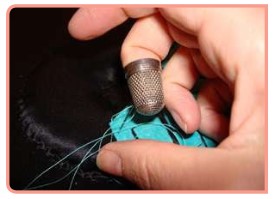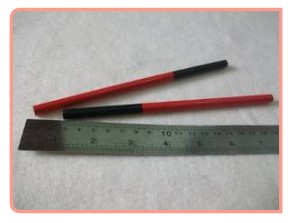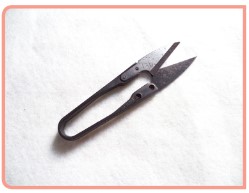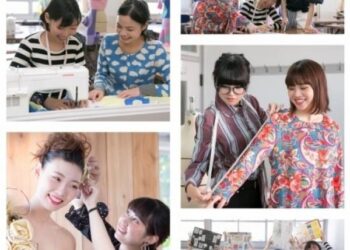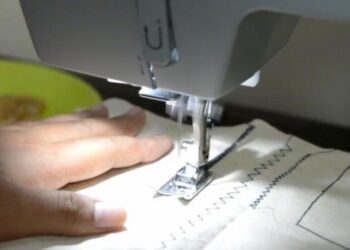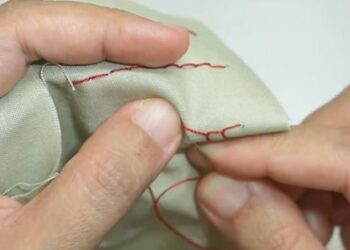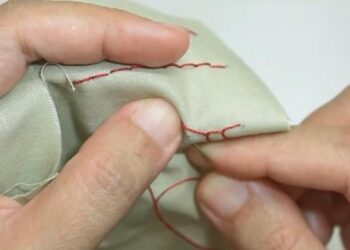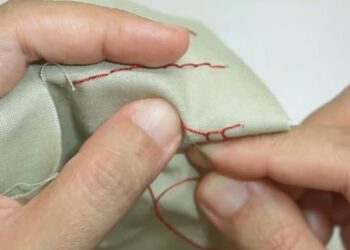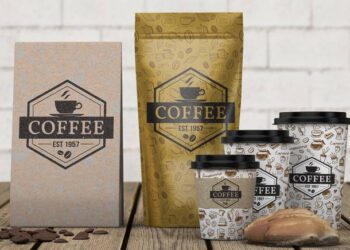Sewing is basically the job of combining two sheets of fabric, fur, animal skin, or other materials that can be passed by sewing needles as well as yarns. The person whose sewing job is called a tailor. Tailors themselves are distinguished by two terms, tailors who sew women’s clothing are called modiste, and tailors who sew men’s clothes called tailors..
To be able to do sewing work, we need to know about the basic techniques in sewing, especially for beginners who are just starting to learn to sew. Sewing is a job that requires sewing and patience, so to be able to get good seam results we are required to continue practicing.
A. Tools Used In Basic Sewing Techniques
Like most jobs, sewing requires equipment to be prepared. Some sewing equipment, such as:
1. Sewing Needles
Sewing needles are one of the basic equipment used for sewing. A rod-shaped sewing needle with one end that is pointed and the other end that has a needle eye in the form of a small hole that serves as a place to pass through the yarn.
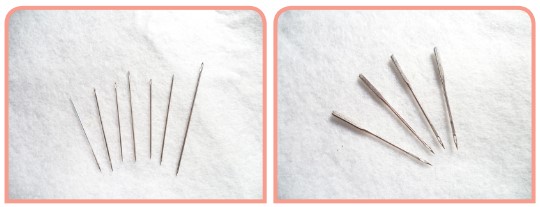
In ancient times, needles were made of natural materials derived from animal bones or wood. While in more modern times as it is today, needles are made of high carbon steel wire, which is coated by nickel or gold to prevent needles from being easily corrosiond/ cared. Needles usually have a size number in each package. The smaller the needle number, the larger the size of the needle. And vice versa. If the hand sewing needle has a hole as a place of passing yarn at the base of the needle, then it is different from the needle of the sewing machine. The sewing machine needle has a needle eye that is located before the pointy part of the needle.
Tips for choosing a sewing needle
a. Match between the sewing needle and the machine
Each sewing machine uses a different needle. Needles used for obras machines or neci machines, of course different from needles used for ordinary machines. For example, sewing machines that are 4000 sh/min or between 4000-5500 rpm, then the needle used is db type needle x 1. As for the usual obras sewing machine using needles of type DC x 27.
b. Choose a highly qualified needle
Today, many original products are counterfeited, including needles though. That’s why we need jelly to distinguish which products are genuine with counterfeit products, so that the needles we use are really quality needles.
c. Adjust between the size of the needle and the material to be sewn The wrong needle selection can actually damage the material to be sewn. That’s why we need to adjust the needle to be used. For example, to sew thin materials such as chiffon, then the needles used are needles number 9 and 11. When the material to be sewn is a cotton material that has a medium thickness, then the needles used are needles number 13 and 14. But when sewing thick materials such as jeans, then the needle size used is needle number 17 and 18.
d. Select the needle that corresponds to the yarn to be used To sew the thick materials, the automatic yarn used is a thick yarn. If the yarn is thick, then the needle used must also be a large needle, in order for the yarn to enter the pinhole.
2. Sewing Machine
Sewing machines are sewing aids that use mechanical and electromagnetic power as their driving force. In the past we only knew manual sewing machines, which are sewing machines driven by hand or foot. But as it develops, sewing machines are now equipped with dynamos so that they can be driven using electric power. The features offered by each sewing machine also vary. The more complete the stitch viture, the more expensive it will be. For beginners who want to learn to sew, there is now also a portable sewing machine with mini size and affordable price. The operation is very simple, so it is suitable for simply learning to sew and make craft goods and household supplies, such as combs, tablecloths, dish cloths, and sewing clothes with less thick materials.
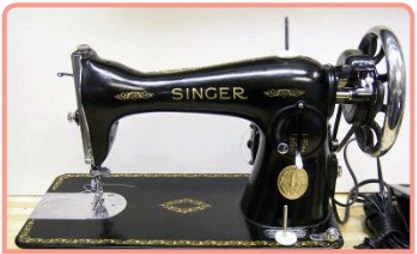
3. Sewing Yarn
Sewing Yarns are an important equipment in sewing activities. The sewing yarn to be used must be adjusted to the material to be sewn as well as the small size of the seam. Sewing yarns are made of natural materials, such as wools or hemp. But some are also made of synthetic materials. It should also be a concern. If we want to sew fabric from natural materials, use yarns of natural fibers. The number of yarn brands circulating in the market requires that we know which yarns are of good quality and which yarns are of poor quality. In Indonesia, the most searched yarn brand is Astra brand. In addition to its good yarn quality, Astra brand yarn also has more color options.
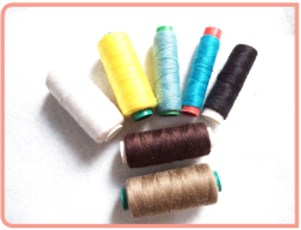
4. Reflective Needles/Jarum Pentul
The reflective needle has almost the same shape as the hand sewing needle. It’s just that the reflective needle doesn’t have a needle eye as a place where the yarn passes, so the reflective needle can’t be used for sewing. The reflective needle serves to pin the pattern or pin two sheets of cloth to be sewn so that the position does not shift. In addition, the reflective needle also serves to pin the fabric when the clothes are done.
The reflective needle has a needle head that is a colorful round. This round serves to protect the finger from being thrown by the needle as we push it. The reflective needle is also shaped like a nail. The size of the nail reflector needle is smaller than a regular reflective needle.
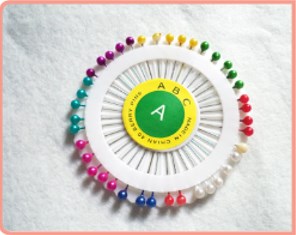
5. Needle Pads/Bantalan Jarum
Needle pads are the place to stick the needles we use when sewing, both sewing needles and reflective needles. The purpose of sticking a needle in a needle pad is so that it doesn’t taint and doesn’t hurt us. Needle pads can be made of cork or sponge. Needle pads can also be made by yourself. When fitting clothes, the tailor should use a needle pad in the shape of a bracelet. So that the tailor does not have to bother looking for needles when trying to pin the fabric.
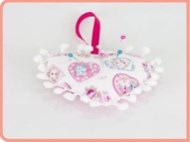
6. Scissors
Sewing activities are definitely not separated from cutting activities. This is where the role of scissors works. The scissors that we need in sewing activities there are two kinds, namely cloth scissors and paper scissors. Fabric scissors serve to cut the fabric we want to sew, while paper scissors serve to cut pattern paper. Do not use cloth scissors to cut paper, and vice versa. This can cause scissors to quickly break down and blunt.

7. Sewing Chalk
Sewing chalk is usually triangular plates of color. Sewing chalk is used to mark patterns on fabrics. Sewing chalk is easy to remove and will come off when washed. So the sewing chalk won’t get on the fabric. Now, there is sewing chalk that is shaped like a pencil.
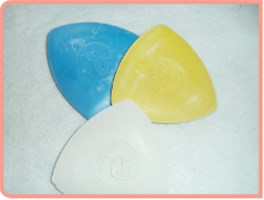
8. Rader/Roda Bergerigi
Rader / gear wheel is a useful tool for marking fabrics. Rader / gear wheel is used together with carbon. How to mark the fabric using a rader / gear wheel can only be done on the bad part of the fabric. For light fabrics, marking with a rader is not recommended. This is to prevent the fabric from tearing easily.
9. Thumbs/Finger Caps
Thumbs/Finger Capsare usually made of metal. The function is to protect our fingers when pressing the needle when sewing by hand. Thumbs/Finger Caps worn on the middle finger.
10. Sewing Pencil
If you look closely, sewing pencils are similar to ordinary pencils. However, on closer inspection, a sewing pencil contains two different colored parts. One end is blue, while the other end is red.
11. Cekris (Yarn Cutter)
Cekris is a yarn cutting tool. It looks like a small scissor with a pointed tip. Cekris also has two sharp blades, making it faster when used to cut yarns than using scissors. The result of the piece is also neater because the yarn can be cut mepet. How it works by pressing two sides of the blade facing each other like levers.
12. Seam Ripper
Seam Ripper serves to disassemble the wrong stitches. Disassemble seams using the Seam Ripper is safer and does not damage the fabric than disassemble the seams using razors.
After we discuss one by one the equipment needed for sewing, we also need to know what equipment needs to be prepared to make a pattern, we need to know that patterns and sewing activities are two inseparable things. To discuss stitch patterns and so on. I will continue in the next article. Thank you for reading 🙂



